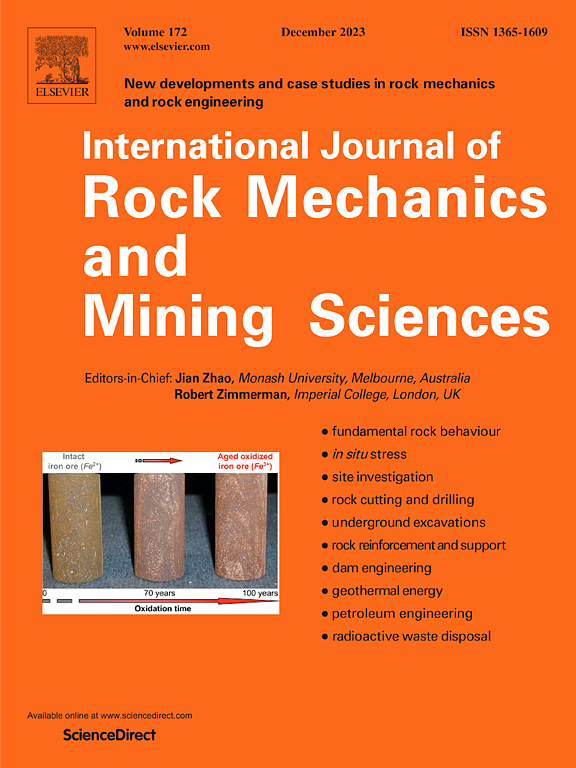使用混合磨料提高花岗岩和混凝土切割效率
IF 7
1区 工程技术
Q1 ENGINEERING, GEOLOGICAL
International Journal of Rock Mechanics and Mining Sciences
Pub Date : 2024-11-22
DOI:10.1016/j.ijrmms.2024.105970
引用次数: 0
摘要
石榴石和钢丸作为使用加砂水刀切割岩石和混凝土的单一砂料,在切割性能和经济效益方面各有利弊。然而,由于单一砂料的切割性能和成本限制,加砂水刀技术在建筑工地的应用仍然有限。为了有效地在现场应用加砂水刀技术,需要一种新的策略。本研究将石榴石和钢丸以不同质量比混合而成的混合磨料应用于加砂水刀切割,以解决石榴石和钢丸的局限性,并优化其优势。实验评估了混合磨料的切割特性,并对花岗岩和混凝土进行了成本分析。切割实验中使用的花岗岩和混凝土均为脆性材料,其 P 波速度分别为 5346 m/s 和 3968 m/s,单轴抗压强度分别为 236 MPa 和 49 MPa。混合磨料分为新鲜混合磨料和回收混合磨料。混合磨料又分为新鲜混合磨料和回收混合磨料,后者又分为重复使用混合磨料和浸没混合磨料,并采用自然干燥法和烘箱干燥法对其切割性能进行了评估。为了最大限度地提高切割效率(比能量),最好采用约 11 克/秒的磨料流速。综合考虑切割性能和经济效益,石榴石和钢丸的最佳混合比例为 50:50。根据磨料成本比,花岗岩和混凝土的临界磨料收集率分别为 18-21 % 和 28-37%。总之,研究证实,在实际应用中,使用混合磨料进行高效切割是可行的。此外,考虑到磨料的市场价格波动,本研究的结果为方法设计提供了适当的指导。因此,加砂水刀技术有望在该领域得到有效应用。本文章由计算机程序翻译,如有差异,请以英文原文为准。
Improvement of granite and concrete cutting efficiency using mixed-abrasives
Garnet and steel shot have advantages and disadvantages in terms of cutting performance and economic efficiency as single abrasive materials for cutting rock and concrete using abrasive waterjet. However, the application of abrasive waterjet technology in construction sites is still limited due to the cutting performance and cost limitations of single abrasive. A new strategy is needed for effective field application of abrasive waterjet technology. In this study, mixed-abrasives, which are mixtures of garnet and steel shot at various mass ratios, were applied to abrasive waterjet cutting to address the limitations of garnet and steel shot, and optimize their advantages. The cutting characteristics of mixed-abrasives were experimentally evaluated, and cost analysis of granite and concrete was performed. Granite and concrete used in the cutting experiment are brittle materials with P-wave velocity of 5346 m/s and 3968 m/s, a uniaxial compressive strength of 236 MPa and 49 MPa, respectively. Mixed-abrasives were classified into fresh and recycled mixed-abrasives. The latter was categorized into reused and submerged conditions, and its cutting performance was evaluated using natural and oven-drying methods. To maximize cutting efficiency in terms of specific energy, it is desirable to apply an abrasive flow rate of approximately 11 g/s. By comprehensively considering cutting performance and economic efficiency, the optimal mixing ratio of garnet and steel shot was 50:50. The critical abrasive collect rates of granite and concrete were evaluated at 18–21 % and 28–37 %, respectively, depending on the abrasive cost ratio. In conclusion, it was confirmed that efficient cutting using mixed-abrasives is possible in terms of practical applications. In addition, the results of this study provide appropriate guidelines for method design considering market price fluctuations of abrasives. Therefore, it is expected that effective application of abrasive waterjet technology to the field is possible.
求助全文
通过发布文献求助,成功后即可免费获取论文全文。
去求助
来源期刊
CiteScore
14.00
自引率
5.60%
发文量
196
审稿时长
18 weeks
期刊介绍:
The International Journal of Rock Mechanics and Mining Sciences focuses on original research, new developments, site measurements, and case studies within the fields of rock mechanics and rock engineering. Serving as an international platform, it showcases high-quality papers addressing rock mechanics and the application of its principles and techniques in mining and civil engineering projects situated on or within rock masses. These projects encompass a wide range, including slopes, open-pit mines, quarries, shafts, tunnels, caverns, underground mines, metro systems, dams, hydro-electric stations, geothermal energy, petroleum engineering, and radioactive waste disposal. The journal welcomes submissions on various topics, with particular interest in theoretical advancements, analytical and numerical methods, rock testing, site investigation, and case studies.

 求助内容:
求助内容: 应助结果提醒方式:
应助结果提醒方式:


